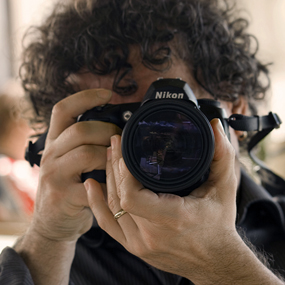

Join BirdNote tomorrow, November 30th!
Illustrator David Sibley and actor H. Jon Benjamin will face off in the bird illustration battle of the century during BirdNote's Year-end Celebration and Auction!
Birds see better than we do. Birds see objects in fine detail, two-and-a-half to three times farther away than we can. Their eyes have the most highly developed retina of any animal. Avian sensitivity to the spectrum of light is far beyond ours. This Eurasian Kestrel uses its ability to see ultraviolet light to track its prey. A vole's urine for example, leaves a shining path reflecting UV light that this small falcon can follow. And the waxy surface of many fruits and berries reflects UV light, attracting hungry birds.
BirdNote®
Birds See Better
Written by Todd Peterson
This is BirdNote.
Birds see better than we do. Birds see objects in fine detail, two-and-a-half to three times farther away than we can. Their eyes have the most highly developed retina of any animal. Avian sensitivity to the spectrum of light is far beyond ours. (1)
[Call of Eurasian Kestrel]
The Eurasian Kestrel we’re hearing uses its ability to see ultraviolet light to track its prey. A vole’s urine for example, leaves a shining path reflecting UV light that this small falcon can follow. And the waxy surface of many fruits and berries reflects UV light attracting hungry birds such as these American Robins.
[Calls and songs of American Robins]
Seeing UV light enables birds not only to find food, but to identify an appropriate mate, and to see clearly at dawn and dusk when the world is dim to us.
The chocolate-brown heads of adult and juvenile drake pintails, for example, reflect UV light differently. And the difference helps pintail hens choose age-appropriate mates.
[Whistles of drake Northern Pintails and calls of hen Northern Pintails]
The night vision of some birds such as owls is justifiably famous. A little moonlight goes a long way in providing an owl with a clear view of the world.
[Hooting of Great Horned Owl]
So day and night, birds see better than we do.
For BirdNote.org, I’m Mary McCann.
###
Bird sounds provided by The Macaulay Library at the Cornell Lab of Ornithology, Ithaca, New York. Eurasian Kestrel recorded by Matt Medler; calls and songs of the American Robin by G.A. Keller; calls of drake and hen Northern Pintails by W.W. H. Gunn; hoots of male and female the Great Horned Owl by W.R.Fish.
Producer: John Kessler
Executive Producer: Chris Peterson
© 2010 Tune In to Nature.org
ID# sight-07 sight-07-2010-03-30-MM
Reference 1. “A Bird’s-Eye View” by Kurt A. Anderson, Joshua M. Unghire and John Coluccy, Ph.D., Ducks Unlimited magazine, January/February 2010. Pages 16 & 17.




